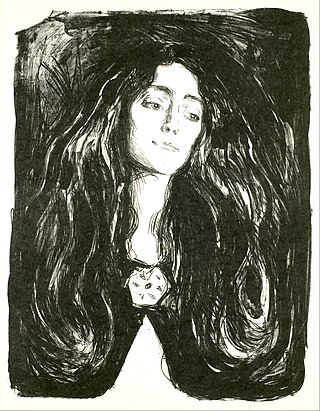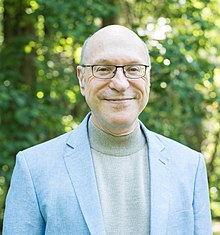Bipolar I disorder is a type of bipolar spectrum disorder characterized by the occurrence of at least one manic episode, with or without mixed or psychotic features. Most people also, at other times, have one or more depressive episodes. Typically, these manic episodes can last at least 7 days for most of each day to the extent that the individual may need medical attention, while the depressive episodes last at least 2 weeks.

Major depressive disorder (MDD), also known as clinical depression, is a mental disorder characterized by at least two weeks of pervasive low mood, low self-esteem, and loss of interest or pleasure in normally enjoyable activities. Introduced by a group of US clinicians in the mid-1970s, the term was adopted by the American Psychiatric Association for this symptom cluster under mood disorders in the 1980 version of the Diagnostic and Statistical Manual of Mental Disorders (DSM-III), and has become widely used since. The disorder causes the second-most years lived with disability, after lower back pain.

A mood disorder, also known as an affective disorder, is any of a group of conditions of mental and behavioral disorder where the main underlying characteristic is a disturbance in the person's mood. The classification is in the Diagnostic and Statistical Manual of Mental Disorders (DSM) and International Classification of Diseases (ICD).

Seasonal affective disorder (SAD) is a mood disorder subset in which people who typically have normal mental health throughout most of the year exhibit depressive symptoms at the same time each year. It is commonly, but not always, associated with the reductions or increases in total daily sunlight hours that occur during the summer or winter.

Borderline personality disorder (BPD) is a personality disorder characterized by a pervasive, long-term pattern of significant interpersonal relationship instability, a distorted sense of self, and intense emotional responses. People diagnosed with BPD frequently exhibit self-harming behaviours and engage in risky activities, primarily due to challenges regulating emotional states to a healthy, stable baseline. Symptoms such as dissociation, a pervasive sense of emptiness, and an acute fear of abandonment are prevalent among those affected.
Schizoaffective disorder is a mental disorder characterized by symptoms of both schizophrenia (psychosis) and a mood disorder - either bipolar disorder or depression. The main diagnostic criterion is the presence of psychotic symptoms for at least two weeks without prominent mood symptoms. Common symptoms include hallucinations, delusions, disorganized speech and thinking, as well as mood episodes. Schizoaffective disorder can often be misdiagnosed when the correct diagnosis may be psychotic depression, bipolar I disorder, schizophreniform disorder, or schizophrenia. This is a problem as treatment and prognosis differ greatly for most of these diagnoses. Many people with schizoaffective disorder have other mental disorders including anxiety disorders.
The National Institute of Mental Health (NIMH) is one of 27 institutes and centers that make up the National Institutes of Health (NIH). The NIH, in turn, is an agency of the United States Department of Health and Human Services and is the primary agency of the United States government responsible for biomedical and health-related research.

Depression is a mental state of low mood and aversion to activity. It affects about 3.5% of the global population, or about 280 million people of all ages. Depression affects a person's thoughts, behavior, feelings, and sense of well-being. Experiences that would normally bring a person pleasure or joy give reduced pleasure or joy, and the afflicted person often experiences a loss of motivation or interest in those activities.
Dysthymia, also known as persistent depressive disorder (PDD), is a mental and behavioral disorder, specifically a disorder primarily of mood, consisting of similar cognitive and physical problems as major depressive disorder, but with longer-lasting symptoms. The concept was used by Robert Spitzer as a replacement for the term "depressive personality" in the late 1970s.
Biological psychiatry or biopsychiatry is an approach to psychiatry that aims to understand mental disorder in terms of the biological function of the nervous system. It is interdisciplinary in its approach and draws on sciences such as neuroscience, psychopharmacology, biochemistry, genetics, epigenetics and physiology to investigate the biological bases of behavior and psychopathology. Biopsychiatry is the branch of medicine which deals with the study of the biological function of the nervous system in mental disorders.
Negative air ionization therapy (NAIs) uses air ionisers as a non-pharmaceutical treatment for respiratory disease, allergy, or stress-related health conditions. The mainstream scientific community considers many applications of NAIs to be pseudoscience. Many negative ion products release ozone, a chemical known to cause lung damage.
Frederick King Goodwin was an American psychiatrist and Clinical Professor of Psychiatry at the George Washington University Medical Center, where he was also director of the Center on Neuroscience, Medical Progress, and Society. He was a specialist in bipolar disorder and recurrent depression.
What was previously known as melancholia and is now known as clinical depression, major depression, or simply depression and commonly referred to as major depressive disorder by many health care professionals, has a long history, with similar conditions being described at least as far back as classical times.
Thomas Alvin Wehr is an American psychiatrist, research scientist, and author. He is a scientist emeritus and former chief of the Clinical Psychobiology branch of the National Institute of Mental Health (NIMH).

Transcendence: Healing and Transformation Through Transcendental Meditation is a book written by psychiatrist and researcher Norman E. Rosenthal, published in 2011 by the Tarcher imprint of the Penguin Group. It presents the author's personal experiences and professional views on Transcendental Meditation research, as well as interviews with celebrity practitioners. The book contains a foreword by Mehmet Oz and four main sections entitled: "Transcendence", "Healing", "Transformation", and "Harmony."
Michael Terman is an American psychologist best known for his work in applying the biological principles of the circadian timing system to psychiatric treatments for depression and sleep disorders. This subspecialty is known as Chronotherapeutics.
Occupational therapy is used to manage the issues caused by seasonal affective disorder (SAD). Occupational therapists assist with the management of SAD through the incorporation of a variety of healthcare disciplines into therapeutic practice. Potential patients with SAD are assessed, treated, and evaluated primarily using treatments such as drug therapies, light therapies, and psychological therapies. Therapists are often involved in designing an individualised treatment plan that most effectively meets the client's goals and needs around their responsiveness to a variety of treatments.
Ronald Robert Fieve was an American psychiatrist known for his work on the use of lithium in treatment of mood disorders. He has authored four popular science books, "Moodswing", "Bipolar II", "Prozac" and "Bipolar Breakthrough".
Augustus John Rush is an internationally renowned psychiatrist. He is a professor emeritus in Duke-NUS Medical School at the National University of Singapore (NUS), and adjunct professor of psychiatry and behavioral sciences at Duke University School of Medicine. He has authored and edited more than 10 books, and over 600 scientific journal articles that are largely focused on the diagnosis and treatment of depressive and bipolar disorders.
The Seasonal Pattern Assessment Questionnaire, or SPAQ, is a simple, self-administered screening test for Seasonal Affective Disorder, first developed in 1984. Though some aspects of its accuracy have been questioned since then, it is widely used today, especially by SAD researchers.






